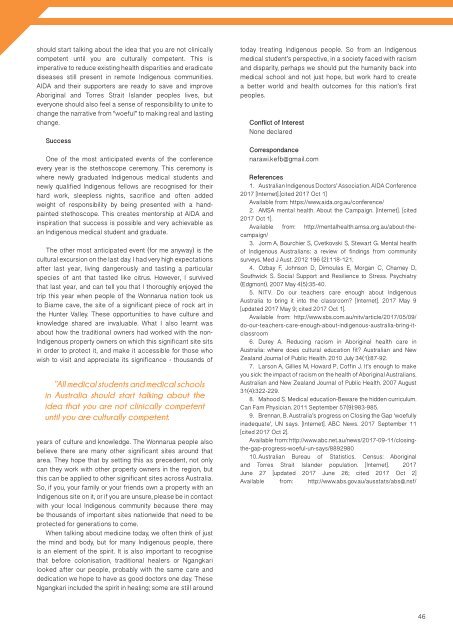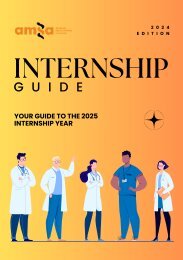Vector Volume 11 Issue 2 - 2017
You also want an ePaper? Increase the reach of your titles
YUMPU automatically turns print PDFs into web optimized ePapers that Google loves.
should start talking about the idea that you are not clinically<br />
competent until you are culturally competent. This is<br />
imperative to reduce existing health disparities and eradicate<br />
diseases still present in remote Indigenous communities.<br />
AIDA and their supporters are ready to save and improve<br />
Aboriginal and Torres Strait Islander peoples lives, but<br />
everyone should also feel a sense of responsibility to unite to<br />
change the narrative from “woeful” to making real and lasting<br />
change.<br />
Success<br />
One of the most anticipated events of the conference<br />
every year is the stethoscope ceremony. This ceremony is<br />
where newly graduated Indigenous medical students and<br />
newly qualified Indigenous fellows are recognised for their<br />
hard work, sleepless nights, sacrifice and often added<br />
weight of responsibility by being presented with a handpainted<br />
stethoscope. This creates mentorship at AIDA and<br />
inspiration that success is possible and very achievable as<br />
an Indigenous medical student and graduate.<br />
The other most anticipated event (for me anyway) is the<br />
cultural excursion on the last day. I had very high expectations<br />
after last year, living dangerously and tasting a particular<br />
species of ant that tasted like citrus. However, I survived<br />
that last year, and can tell you that I thoroughly enjoyed the<br />
trip this year when people of the Wonnarua nation took us<br />
to Biame cave, the site of a significant piece of rock art in<br />
the Hunter Valley. These opportunities to have culture and<br />
knowledge shared are invaluable. What I also learnt was<br />
about how the traditional owners had worked with the non-<br />
Indigenous property owners on which this significant site sits<br />
in order to protect it, and make it accessible for those who<br />
wish to visit and appreciate its significance - thousands of<br />
“All medical students and medical schools<br />
in Australia should start talking about the<br />
idea that you are not clinically competent<br />
until you are culturally competent.<br />
years of culture and knowledge. The Wonnarua people also<br />
believe there are many other significant sites around that<br />
area. They hope that by setting this as precedent, not only<br />
can they work with other property owners in the region, but<br />
this can be applied to other significant sites across Australia.<br />
So, if you, your family or your friends own a property with an<br />
Indigenous site on it, or if you are unsure, please be in contact<br />
with your local Indigenous community because there may<br />
be thousands of important sites nationwide that need to be<br />
protected for generations to come.<br />
When talking about medicine today, we often think of just<br />
the mind and body, but for many Indigenous people, there<br />
is an element of the spirit. It is also important to recognise<br />
that before colonisation, traditional healers or Ngangkari<br />
looked after our people, probably with the same care and<br />
dedication we hope to have as good doctors one day. These<br />
Ngangkari included the spirit in healing; some are still around<br />
today treating Indigenous people. So from an Indigenous<br />
medical student’s perspective, in a society faced with racism<br />
and disparity, perhaps we should put the humanity back into<br />
medical school and not just hope, but work hard to create<br />
a better world and health outcomes for this nation’s first<br />
peoples.<br />
Conflict of Interest<br />
None declared<br />
Correspondance<br />
narawi.kefb@gmail.com<br />
References<br />
1. Australian Indigenous Doctors’ Association. AIDA Conference<br />
<strong>2017</strong> [Internet].[cited <strong>2017</strong> Oct 1]<br />
Available from: https://www.aida.org.au/conference/<br />
2. AMSA mental health. About the Campaign. [Internet]. [cited<br />
<strong>2017</strong> Oct 1].<br />
Available from: http://mentalhealth.amsa.org.au/about-thecampaign/<br />
3. Jorm A, Bourchier S, Cvetkovski S, Stewart G. Mental health<br />
of Indigenous Australians: a review of findings from community<br />
surveys. Med J Aust. 2012 196 (2):<strong>11</strong>8-121.<br />
4. Ozbay F, Johnson D, Dimoulas E, Morgan C, Charney D,<br />
Southwick S. Social Support and Resilience to Stress. Psychiatry<br />
(Edgmont). 2007 May 4(5):35-40.<br />
5. NITV. Do our teachers care enough about Indigenous<br />
Australia to bring it into the classroom? [Internet]. <strong>2017</strong> May 9<br />
[updated <strong>2017</strong> May 9; cited <strong>2017</strong> Oct 1].<br />
Available from: http://www.sbs.com.au/nitv/article/<strong>2017</strong>/05/09/<br />
do-our-teachers-care-enough-about-indigenous-australia-bring-itclassroom<br />
6. Durey A. Reducing racism in Aboriginal health care in<br />
Australia: where does cultural education fit? Australian and New<br />
Zealand Journal of Public Health. 2010 July 34(1):87-92.<br />
7. Larson A, Gillies M, Howard P, Coffin J. It’s enough to make<br />
you sick: the impact of racism on the health of Aboriginal Australians.<br />
Australian and New Zealand Journal of Public Health. 2007 August<br />
31(4):322-229.<br />
8. Mahood S. Medical education-Beware the hidden curriculum.<br />
Can Fam Physician. 20<strong>11</strong> September 57(9):983-985.<br />
9. Brennan, B. Australia’s progress on Closing the Gap ‘woefully<br />
inadequate’, UN says. [Internet]. ABC News. <strong>2017</strong> September <strong>11</strong><br />
[cited <strong>2017</strong> Oct 2].<br />
Available from: http://www.abc.net.au/news/<strong>2017</strong>-09-<strong>11</strong>/closingthe-gap-progress-woeful-un-says/8892980<br />
10. Australian Bureau of Statistics. Census: Aboriginal<br />
and Torres Strait Islander population. [Internet]. <strong>2017</strong><br />
June 27 [updated <strong>2017</strong> June 26; cited <strong>2017</strong> Oct 2]<br />
Available from: http://www.abs.gov.au/ausstats/abs@.nsf/<br />
46

















